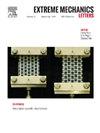The mapping relationship between initiator and mechanical properties of free radical polymerized hydrogels
IF 4.5
3区 工程技术
Q2 MATERIALS SCIENCE, MULTIDISCIPLINARY
引用次数: 0
Abstract
Most of the hydrogels are formed by free radical polymerization of the precursor solution containing monomer, crosslinker, initiator, and water. The change of any one of the components will affect the final network structure, which will lead to different mechanical properties. Although the initiator plays a key role in the synthesis of hydrogels, the mapping relationship between the initiator and the mechanical properties of hydrogels has not been well explained. In this paper, a polyacrylamide hydrogel with high water content is taken as the research object. The influence of the initiator on the elastic modulus and toughness of the hydrogel is analyzed experimentally and theoretically. In theory, we reveal the microscopic mechanism of the initiator on the evolution of the network structure. By taking the kinetic chain length as an intermediate variable, a mechanochemical coupling model is developed to predict the relationship between the initiator and the elastic modulus. The theoretical predictions agree well with the experimental results. Furthermore, we find that initiators can tune the modulus of hydrogels, but have little effect on toughness. These mechanical changes induced by initiators provide more options for hydrogel applications. And utilizing the kinetic chain length as a characteristic parameter for the evolution of the network helps elucidate the impact of free radical polymerization reactions on macroscopic mechanical behavior.
自由基聚合水凝胶引发剂与力学性能的映射关系
大多数水凝胶都是通过自由基聚合含有单体、交联剂、引发剂和水的前体溶液形成的。任何一种成分的改变都会影响最终的网络结构,从而导致不同的机械性能。虽然引发剂在水凝胶的合成中起着关键作用,但引发剂与水凝胶机械性能之间的映射关系尚未得到很好的解释。本文以一种高含水量的聚丙烯酰胺水凝胶为研究对象。实验和理论分析了引发剂对水凝胶弹性模量和韧性的影响。在理论上,我们揭示了引发剂对网络结构演变的微观机理。通过将动力学链长作为中间变量,建立了一个机械化学耦合模型来预测引发剂与弹性模量之间的关系。理论预测与实验结果非常吻合。此外,我们还发现引发剂可以调节水凝胶的模量,但对韧性的影响很小。引发剂引起的这些机械变化为水凝胶的应用提供了更多选择。利用动力学链长作为网络演变的特征参数,有助于阐明自由基聚合反应对宏观机械行为的影响。
本文章由计算机程序翻译,如有差异,请以英文原文为准。
求助全文
约1分钟内获得全文
求助全文
来源期刊

Extreme Mechanics Letters
Engineering-Mechanics of Materials
CiteScore
9.20
自引率
4.30%
发文量
179
审稿时长
45 days
期刊介绍:
Extreme Mechanics Letters (EML) enables rapid communication of research that highlights the role of mechanics in multi-disciplinary areas across materials science, physics, chemistry, biology, medicine and engineering. Emphasis is on the impact, depth and originality of new concepts, methods and observations at the forefront of applied sciences.
 求助内容:
求助内容: 应助结果提醒方式:
应助结果提醒方式:


